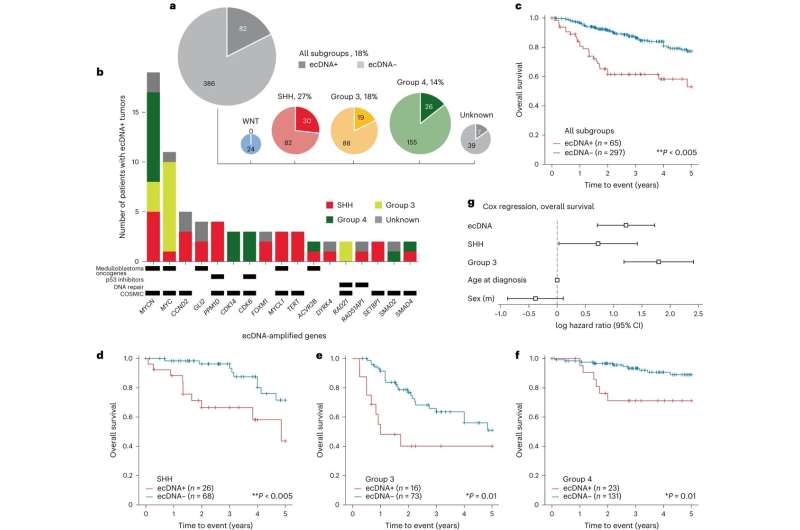This article has been reviewed according to Science X's editorial process and policies. Editors have highlighted the following attributes while ensuring the content's credibility:
fact-checked
peer-reviewed publication
trusted source
proofread
'DNA loops' in pediatric brain tumors double relapse risk, study finds

A study of newly created databases of medulloblastoma has found that patients with tumors containing circular extrachromosomal DNA—loops of DNA found outside of regular chromosomes—are twice as likely to relapse and three times as likely to die within five years of diagnosis. The findings, published in Nature Genetics, pave the way for research that could yield new treatments for this aggressive childhood brain cancer.
"There are very few effective treatments available for medulloblastoma, and most treatments carry substantial risks of brain damage or secondary cancers," says senior author Lukas Chavez, Ph.D., a professor in the Cancer Genome and Epigenetics Program at Sanford Burnham Prebys. "There is a critical need for new therapies that minimize unwanted side effects. There is still so much we need to learn about what drives medulloblastoma at the molecular level, and this study is a step in the right direction."
There are around 350 new medulloblastoma diagnoses per year, and most of these are in children. Medulloblastoma is extremely aggressive and often resists treatment, which involves a combination of surgery, radiation, and chemotherapy. Because medulloblastoma is relatively rare and has different subtypes, it has been difficult for researchers to discover new treatments for the disease.
"Because medulloblastoma is rare, one of the challenges of studying the cancer is compiling enough patient data to study the disease holistically," says Chavez. "Fortunately, modern technology is now democratizing data science, which is transforming the way we study rare cancers."
The research team compiled a database of 465 medulloblastoma patients using a combination of publicly available data and data from patients diagnosed at Rady Children's Hospital. The analysis focused on circular extrachromosomal DNA (ecDNA), circular fragments of DNA that are outside of regular chromosomes. These DNA loops can contain hundreds of copies of cancer-causing genes and are known to be present in many cancers, but until now, their effects have not been thoroughly investigated in medulloblastoma or other childhood cancers.
"These ecDNA fragments are unique to cancer cells, and understanding how and why these DNA loops form and uncovering ways to therapeutically target them is a significant goal for researchers studying cancers of all types, not just medulloblastoma," says Chavez.
Using computational tools to detect ecDNA within the patients' tumors, the study revealed that while only 18% had ecDNA, these patients were twice as likely to relapse and three times as likely to die within five years of their diagnosis.
"We're finding that the presence of ecDNA fragments has a strong association with the clinical outcomes of medulloblastoma," says Chavez.
The researchers then analyzed individual tumors, and found that even within a single tumor, there was a large amount of variety in how much and what kinds of ecDNA were present in individual cells.
"The genetic variety between different cells within the same tumor could help explain why medulloblastoma is so capable of evolving to resist treatment," says Chavez. "While some tumor cells may be eliminated, others survive the treatment and continue to grow."
The researchers hope that in the future, it will be possible to find new drugs that can interfere with the effects of ecDNA, though it will take more research to discover how these drugs could work.
"We're starting to see what ecDNA does in cancer, but we're still working on figuring out how it happens and what we can do to stop it," says Chavez. "While there is still a lot to learn about ecDNA, the work we've done here will help pave the way for future medulloblastoma therapies."
More information: Owen S. Chapman et al, Circular extrachromosomal DNA promotes tumor heterogeneity in high-risk medulloblastoma, Nature Genetics (2023). DOI: 10.1038/s41588-023-01551-3



















